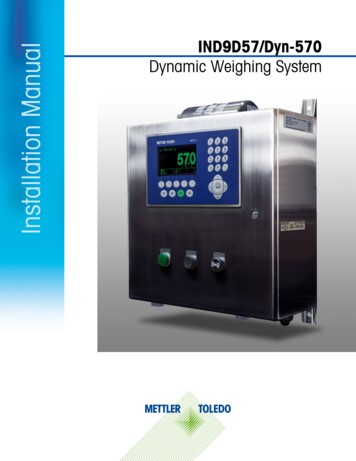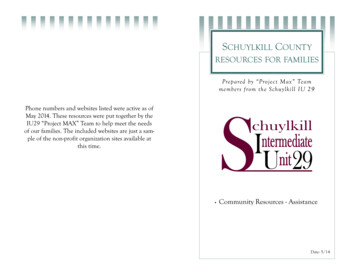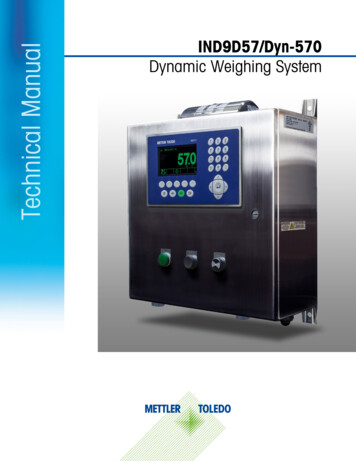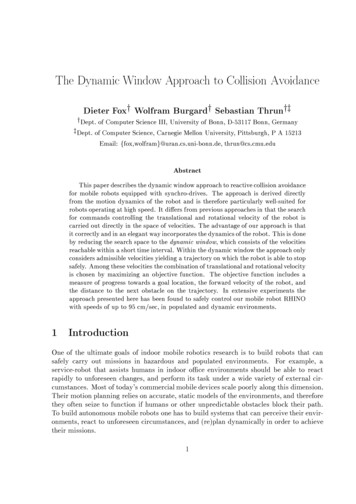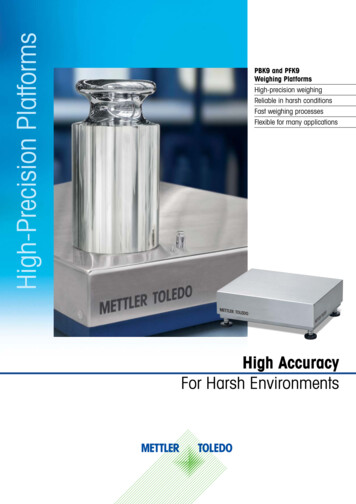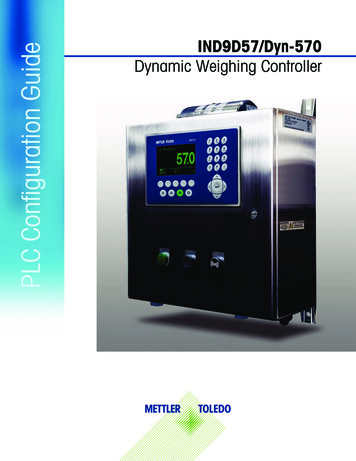
Transcription
PLC Configuration GuideIND9D57/Dyn-570Dynamic Weighing Controller
IND9D57/Dyn-570Dynamic Weighing SystemEssential Services for Dependable Performance of Your IND9D57/Dyn-570 Dynamic WeighingSystemCongratulations on choosing the quality and precision of METTLER TOLEDO. Proper use of yournew equipment according to this Manual and regular calibration and maintenance by our factorytrained service team ensures dependable and accurate operation, protecting your investment.Contact us about a service agreement tailored to your needs and budget. Further information isavailable at www.mt.com/service.There are several important ways to ensure you maximize the performance of your investment:1.Register your product: We invite you to register your product atwww.mt.com/productregistration so we can contact you about enhancements, updates andimportant notifications concerning your product.2.Contact METTLER TOLEDO for service: The value of a measurement is proportional to itsaccuracy – an out of specification scale can diminish quality, reduce profits and increaseliability. Timely service from METTLER TOLEDO will ensure accuracy and optimize uptime andequipment life.a. Installation, Configuration, Integration and Training: Our service representatives are factorytrained, weighing equipment experts. We make certain that your weighing equipment isready for production in a cost effective and timely fashion and that personnel are trained forsuccess.b. Initial Calibration Documentation: The installation environment and applicationrequirements are unique for every industrial scale so performance must be tested andcertified. Our calibration services and certificates document accuracy to ensure productionquality and provide a quality system record of performance.c. Periodic Calibration Maintenance: A Calibration Service Agreement provides on-goingconfidence in your weighing process and documentation of compliance with requirements.We offer a variety of service plans that are scheduled to meet your needs and designed tofit your budget.d. GWP Verification: A risk-based approach for managing weighing equipment allows forcontrol and improvement of the entire measuring process, which ensures reproducibleproduct quality and minimizes process costs. GWP (Good Weighing Practice), the sciencebased standard for efficient life-cycle management of weighing equipment, gives clearanswers about how to specify, calibrate and ensure accuracy of weighing equipment,independent of make or brand.
Contents30415412 00 06/20171Overview . 1-11.1.Cyclic Sample Overview . 1-11.2.Shared Data Access Sample Overview . 1-31.3.Basic Configuration . 1-31.3.1.1.3.2.1.3.3.Application . 1-3Terminal . 1-5Communications . 1-62EtherNet/IP . 2-12.1.PLC Configuration . 2-12.2.IND9D57 Setup . 2-22.2.1.Communications . 2-23ControlNet. 3-13.1.PLC Configuration . 3-13.2.IND9D57 Setup . 3-23.2.1.Communications . 3-24DeviceNet . 4-14.1.PLC Configuration . 4-14.2.IND9D57 Setup . 4-34.2.1.Communications . 4-35PROFIBUS . 5-15.1.PLCs used for samples . 5-15.2.Notes on Shared Data Access with PROFIBUS . 5-15.3.IND9D57 Cyclic Data Access Setup in the PLC . 5-35.3.1.IND9D57 Setup Menu . 5-45.4.IND9D57 Shared Data Access Setup in the PLC . 5-55.4.1.IND9D57 Setup Menu . 5-76PROFINET . 6-16.1.PLCs used for samples . 6-16.2.Notes on Shared Data Access with PROFINET . 6-16.2.1.6.2.2.Shared Data Writes . 6-1Shared Data Reads . 6-26.3.IND9D57 Setup in the PLC . 6-36.4.IND9D57 Setup Menu. 6-46.4.1.Communications . 6-4METTLER TOLEDO IND9D57/Dyn-570 Dynamic Weighing System PLC Configuration Guide1
1OverviewThis document provides the configuration requirements of the IND9D57 unit that will allow it towork with the provided PLC sample code.The sample code is divided two ways:1. By Fieldbus. The fieldbuses demonstrated are:a. Ethernet/IPb. ControlNetc. DeviceNetd. PROFIBUSe. PROFINET2. By the type of messaging useda. Cyclic (all 5 fieldbuses)b. Shared Data Access, which is typically accomplished with Acyclic or Explicit messaging,with the following notes:i. DeviceNet has no Acyclic/Explicit messaging capabilityii. PROFIBUS is also handled entirely with Cyclic messages. However, a method ofaccessing Shared Data in the terminal is provided with the terminal, and is used for thissample.1.1.Cyclic Sample OverviewThe cyclic data samples have simpler PLC logic because they take advantage of the cyclic data linkbetween the PLC and the IND957D. But to do this, they require that Outputs 3, 4, and 5 on theIND9D57 be wired back into Input 3 as shown below, so that a new Processed Weight reading, oran error, will trigger the PLC program to go read the current value of the Floating Point data beingreturned to the PLC.30415412 00 06/2017METTLER TOLEDO IND9D57/Dyn-570 Dynamic Weighing System PLC Configuration Guide1-1
OverviewFigure 1-1: IND570 Dynamic Weighing – Cyclic Data I/O WiringThe cyclic data sample programs take advantage of the fact that IND9D57 puts the most recentProcessed Weight captured into Shared Data Variable AJ0101.The sample program sends Floating Point Command 17 to the IND9D57, which causes theterminal to return the value for Shared Data Variable AJ0101 in the Floating Point data. The floatingpoint data can then be read when a new Processed Weight is detected (Input 3 goes high) tocapture the new Processed Weight.If the Processed Weight read is a negative value, then this indicates that an error has occurred, andthe value returned in the Floating Point data is an error code indicating what the error was.The IND9D57 also returns an Over/Under/OK status in the Cyclic Data Scale Status word using theFeed, Fast Feed, and Tolerance OK status bits as follows:1-2 Feed Under Target Value Fast Feed Value OK Tolerance OK Over Target Value.METTLER TOLEDO IND9D57/Dyn-570 Dynamic Weighing System PLC Configuration Guide30415412 00 06/2017
1.2.Shared Data Access Sample OverviewBecause the Shared Data Access samples can monitor all of the IND9D57's I/O, no additionalwiring of the unit is required. However, the PLC logic tends to be more complicated so that it canhandle the various methods for Shared Data Access.The PLC does a composite read of all of the IND9D57's I/O so that the states of the unit's inputsand outputs come back into the PLC about 10 times per second.The PLC monitors the returned status bit for Output 3. When that bit goes high, the IND9D57 isindicating that a new Processed Weight is available. This triggers the PLC to read Shared DataVariable IW0103 and record this as the Processed Weight.The PLC also monitors the returned status bits for Outputs 4 and 5, which are the Fatal and NonFatal Errors respectively. If either of these bits go high then the error code is read from Shared DataVariable AJ0101.After a Processed Weight has been Read by the PLC, the Over/Under/Okay status may be read bythe PLC by triggering reads of the Shared Data Variables AS0109 (Over), AS0110 (Okay), andAS0111 (Under). The PLC then sets the appropriate Over/Under/Ok flags depending on the resultsof these reads.1.3.Basic ConfigurationThe following Setup configuration of the IND9D57 terminal is recommended for use with the PLCSample Code. Your actual configuration may vary.Note that the configuration for the PLC interface is included in the sections for each .Target TableMode Over/UnderTolerance Type Target DeviationTotalization Disabled1.3.1.2.Operation1.3.1.2.1.TargetSource Average WeightMotion Check Disabled1.3.1.2.2.ComparatorsNo Comparators are defined.30415412 00 06/2017METTLER TOLEDO IND9D57/Dyn-570 Dynamic Weighing System PLC Configuration Guide1-3
1.3.1.2.3.TotalizationMode None.Overview1.3.1.2.4.ID1ID1 Mode Disabled.1.3.1.2.5.ID2ID2 Mode Disabled.1.3.1.2.6.ID3ID3 Mode Disabled.1.3.1.2.7.ID4ID4 Mode Disabled.1.3.1.3.Discrete I/O1.3.1.3.1.Inputs0.1.4 Silence Alarm1.3.1.3.2.Outputs0.1.1 Running0.1.2 Scale Empty0.1.3 Weigh Complete0.1.4 Alarm Fatal0.1.5 Alarm Non-Fatal1.3.1.4.PAC1.3.1.4.1.SystemSystem Type CheckweighTransmit PE3 DisabledTransmit Delay 0 SecondsReject Disabled1.3.1.4.2.DisplayDisplay Time 2 SecondsDisplay Info LiteralDisplay Literal Processed Weight1.3.1.4.3.PhotoeyesPE 1 Timer 150 mSPE 2 Timer 50 mSPE1 to PE2 Timer 3 SecondsPE1 & PE2 Maximum 5 Seconds1-4METTLER TOLEDO IND9D57/Dyn-570 Dynamic Weighing System PLC Configuration Guide30415412 00 06/2017
1.3.1.4.4.WeighTime & AutotuneWeigh Time 300 mSNo Autotune needs to be run for the PLC sample code to work.1.3.1.4.5.Dynamic AdjustDynamic Adjust Disabled1.3.1.4.6.Config ErrorLog Errors EnabledSend Error Code EnabledError String 1.3.1.4.7.ID1 InputData Type None1.3.1.4.8.ID2 InputData Type None1.3.1.4.9.Alarm OutputsFatal Alarm Output EnabledNon-Fatal Alarm Output EnabledAuto-clear Alarms Enabled1.3.1.4.10.DYN Target TableFunction not required for configuration1.3.1.4.11.Assign I/ONo need to use this function if above configuration is 2.Task File NameAuto Start1 Dyn Adv.cptEnabledCustom SetupNo Configuration1.3.2.Terminal1.3.2.1.SoftkeysSoftkey 1 Dynamic StartSoftkey 2 Target Table30415412 00 06/2017METTLER TOLEDO IND9D57/Dyn-570 Dynamic Weighing System PLC Configuration Guide1-5
t AssignmentCOM1 Continuous OutputCOM1 CTPZ Input1.3.3.2.Serial1.3.3.2.1.COM1Baud 9600Data Bits 8Parity NoneFlow Control NoneInterface RS-2321-6METTLER TOLEDO IND9D57/Dyn-570 Dynamic Weighing System PLC Configuration Guide30415412 00 06/2017
2EtherNet/IP2.1.PLC ConfigurationThe PLC used for the Ethernet/IP samples is an Allen-Bradley ControlLogix L-71 processor with a1756-ENBT module used for interfacing with the Ethernet/IP network. The sample logic was writtenusing RSLogix5000, Version 20, which can easily be upgraded to the newer versions ofStudio5000.To set up communication between the PLC and the IND9D57, use the IND570 AOP as shownbelow:Figure 2-1: Module Setup1. Right Click on the Ethernet/IP Bridge Module.2. Select "New Module"3. Type "IND570" into the search box, then double-click on the IND570 AOP in the search results.30415412 00 06/2017METTLER TOLEDO IND9D57/Dyn-570 Dynamic Weighing System PLC Configuration Guide2-1
EtherNet/IPFigure 2-2: Module Definition2.2.IND9D57 Setup2.2.1.Communications2.2.1.1.PLC configuration2.2.1.1.1.Ethernet/IPDHCP Client DisabledIP Address 192.168.0.61Subnet Mask 255.255.255.0Gateway 0.0.0.02.2.1.1.2.Data FormatOperating Mode Compatibility ModeFormat Floating PointByte Order Word SwapMessage Slots 12-2METTLER TOLEDO IND9D57/Dyn-570 Dynamic Weighing System PLC Configuration Guide30415412 00 06/2017
3ControlNet3.1.PLC ConfigurationThe PLC used for the ControlNet samples is an Allen-Bradley ControlLogix L-71 processor with a1756-CNBR module used for interfacing with the ControlNet network. The sample logic was writtenusing RSLogix5000, Version 20, which can easily be upgraded to the newer versions ofStudio5000.The IND9D57 uses a Generic ControlNet Module in the PLC, which is configured as follows:Figure 3-1: Module PropertiesControlLogix requires additional configuration using RSNetworx for ControlNet. A configuration filenamed Test.xc is included with the sample code. The connection must be scheduled by RSNetworxbefore the PLC will communicate with the IND9D57.30415412 00 06/2017METTLER TOLEDO IND9D57/Dyn-570 Dynamic Weighing System PLC Configuration Guide3-1
ControlNet3.2.IND9D57 Setup3.2.1.Communications3.2.1.1.PLC configuration3.2.1.1.1.ControlNetNode Address 33.2.1.1.2.Data FormatOperating Mode Compatibility ModeFormat Floating PointByte Order Word SwapMessage Slots 13-2METTLER TOLEDO IND9D57/Dyn-570 Dynamic Weighing System PLC Configuration Guide30415412 00 06/2017
4DeviceNetDeviceNet does not have Acyclic messaging capability, or any way to allow the PLC to accessShared Data within the IND9D57. So, there is only a Cyclic Data example.4.1.PLC ConfigurationThe PLC used for the DeviceNet samples is an Allen-Bradley ControlLogix L-71 processor with a1756-DNB module used for interfacing with the DeviceNet network. The sample logic was writtenusing RSLogix5000, Version 20, which can easily be upgraded to the newer versions ofStudio5000.The 1756-DNB module is configured as follows:Figure 4-1: 1756-DNB Module ConfigurationDeviceNet requires additional configuration using RSNetworx for DeviceNet. A configuration filenamed DNET.dnt is included with the sample code. The connection must be set up by RSNetworxbefore the PLC will communicate with the IND9D57.30415412 00 06/2017METTLER TOLEDO IND9D57/Dyn-570 Dynamic Weighing System PLC Configuration Guide4-1
DeviceNetFigure 4-2: Connection SetupFigure 4-3 shows the I/O mapping:Figure 4-3: I/O Mapping4-2METTLER TOLEDO IND9D57/Dyn-570 Dynamic Weighing System PLC Configuration Guide30415412 00 06/2017
4.2.IND9D57 Setup4.2.1.Communications4.2.1.1.PLC configuration4.2.1.1.1.DeviceNetNode Address 1Data Rate 250 KBaud4.2.1.1.2.Data FormatOperating Mode Compatibility ModeFormat Floating PointByte Order Word Swap30415412 00 06/2017METTLER TOLEDO IND9D57/Dyn-570 Dynamic Weighing System PLC Configuration Guide4-3
5PROFIBUS5.1.PLCs used for samplesTwo PLCs are used for the PROFIBUS samples. An S7-315-2PN/DP, and an S7-1200C-AC/DC/RLY.There are a total of six (6) PROFIBUS samples for these two PLC, organized as follows1. S7-315-2PN/DPa. Classic Step 7, V5.5i. Cyclic Data Accessii. Shared Data Access via Cyclic Messaging.b. TIA Portal V13i. Cyclic Data Accessii. Shared Data Access via Cyclic Messaging.2. S7-1200C-AC/DC/RLY with a 1243-5 PROFIBUS Master modulea. TIA Portal V13i. Cyclic Data Accessii. Shared Data Access via Cyclic Messaging.5.2.Notes on Shared Data Access withPROFIBUSThe IND9D57 implements PROFIBUS DP-V0, which means that Acyclic messages are notsupported. To access Shared Data, a region of the allocated I/O space for the unit is used to requestRead or Write Access, and to receive the results (see the shaded areas in the diagram below).30415412 00 06/2017METTLER TOLEDO IND9D57/Dyn-570 Dynamic Weighing System PLC Configuration Guide5-1
PROFIBUSFigure 5-1: Floating Point Mode with Shared Data AccessThis shaded area shown in Figure 5-1always appears after the regions allocated for the Scale I/O.As a result, the Shared Data Access version of the programs will always use the "I/O 28 Wrd"selection from the Hardware Catalog of the Programming Tool, regardless of how many MessageSlots have been defined for the unit.The Cyclic Data Access versions of the program do not need to access Shared Data. So, they usethe "I/O 4 Wrd" selection from the Hardware Catalog, which is the I/O definition required to interfacewith an IND9D57 set up for a Single Message Slot using Floating Point communications.For these reasons, the PLC communication configurations between the Cyclic Data Access and theShared Data Access versions of the program will be different.5-2METTLER TOLEDO IND9D57/Dyn-570 Dynamic Weighing System PLC Configuration Guide30415412 00 06/2017
5.3.IND9D57 Cyclic Data Access Setup in the PLCThe following figures show the setup for Cyclical Data Access in the PLC.Figure 5-2: S7-315 Step 7, V5.5Figure 5-3: S7-315, TIA Portal, V1330415412 00 06/2017METTLER TOLEDO IND9D57/Dyn-570 Dynamic Weighing System PLC Configuration Guide5-3
PROFIBUSFigure 5-4: S7-1200, TIA Portal, V135.3.1.IND9D57 Setup e 3Shared Data DisabledData FormatOperating Mode Compatibility ModeFormat Floating PointByte Order Byte SwapMessage Slots 15-4METTLER TOLEDO IND9D57/Dyn-570 Dynamic Weighing System PLC Configuration Guide30415412 00 06/2017
5.4.IND9D57 Shared Data Access Setup in the PLCThe following figures show the setup for Shared Data Access in the PLC.Figure 5-5: S7-315 Step 7, V5.530415412 00 06/2017METTLER TOLEDO IND9D57/Dyn-570 Dynamic Weighing System PLC Configuration Guide5-5
PROFIBUSFigure 5-6: S7-315, TIA Portal, V13Figure 5-7: S7-1200, TIA Portal, V135-6METTLER TOLEDO IND9D57/Dyn-570 Dynamic Weighing System PLC Configuration Guide30415412 00 06/2017
5.4.1.IND9D57 Setup e 3Shared Data EnabledData FormatOperating Mode Compatibility ModeFormat Floating PointByte Order Byte SwapMessage Slots 130415412 00 06/2017METTLER TOLEDO IND9D57/Dyn-570 Dynamic Weighing System PLC Configuration Guide5-7
6PROFINET6.1.PLCs used for samplesTwo PLCs are used for the PROFINET samples. An S7-315-2PN/DP, and an S7-1200C-AC/DC/RLY.There are a total of six (6) PROFINET samples for these two PLC, organized as follows1.2.6.2.S7-315-2PN/DPa. Classic Step 7, V5.5i. Cyclic Data Accessii. Shared Data Access via Acyclic Messaging.b. TIA Portal V13i. Cyclic Data Accessii. Shared Data Access via Acyclic Messaging.S7-1200C-AC/DC/RLY with a 1243-5 PROFIBUS Master modulea. TIA Portal V13i. Cyclic Data Accessii. Shared Data Access via Acyclic Messaging.Notes on Shared Data Access with PROFINETWe will provide a brief description for how Shared Data Access is accomplished in this section. Fordetails about how the IND9D57 accesses Shared Data over PROFINET, please review the IND570PLC Manual's (30205335 R03 IND570 PLC EN.pdf) Shared Data Access starting at section7.10.3.Shared Data is accessed using what Mettler Toledo terms the "Indirect Access" method. Themessage functions always use the same Message Index numbers (1, 2, and 3) for Shared DataAccesses. The desired Shared Data Value is specified in the first four words of the message itself byputting in the Class, Instance, Attribute, and length of the desired variable (found in the IND570'sShared Data Reference Manual, 30205337 R01 IND570 SDREF EN.pdf).6.2.1.Shared Data WritesData is written to the IND9D57 using a WRREC function (SFB53) with Index 1. The data to bewritten should immediately follow the header data that specifies what shared data variable it is tobe written to.30415412 00 06/2017METTLER TOLEDO IND9D57/Dyn-570 Dynamic Weighing System PLC Configuration Guide6-1
PROFINETFigure 6-1: Shared Data Write6.2.2.Shared Data ReadsData is read from the IND9D57 with a two-step process.1. Use a WRREC (SFB53) function with Index 2 to send the Class, Instance, Attribute, andLength of the variable requested to be read.2. Use a REREC (SFB52) with Index 3 to read the data from the requested Shared DataVariable. The PLC program should compare the returned Class, Instance, and Attribute with therequested variable to ensure that the data is from the correct source.Note: If the PLC program needs to read the same Shared Data Variable repeatedly, with noother Shared Data accesses occurring in between, then after the initial read only Step 2 isneeded because the IND9D57 remembers the last Shared Data variable that was accessed,and always returns the current data for that value until a new request comes in.Figure 6-2: Shared Data Read6-2METTLER TOLEDO IND9D57/Dyn-570 Dynamic Weighing System PLC Configuration Guide30415412 00 06/2017
6.3.IND9D57 Setup in the PLCThe following figures show setup in the PLC. Note that the configuration will be the same in the PLCfor either Cyclic Data Access or Shared Data Access.Figure 6-3: S7-315 Step 7, V5.5Figure 6-4: S7-315, TIA Portal, V1330415412 00 06/2017METTLER TOLEDO IND9D57/Dyn-570 Dynamic Weighing System PLC Configuration Guide6-3
PROFINETFigure 6-5: S7-1200, TIA Portal, V136.4.IND9D57 Setup Menu6.4.1.Communications6.4.1.1.PLCPROFINETIP Assignment DCPIP Address 172.18.55.128*Subnet Mask 255.255.254.0*Gateway Address 172.18.54.1*Device Name ind570** Indicates Assigned by PLC's DCP system.Data FormatOperating Mode Compatibility ModeFormat Floating PointByte Order Byte SwapMessage Slots 16-4METTLER TOLEDO IND9D57/Dyn-570 Dynamic Weighing System PLC Configuration Guide30415412 00 06/2017
To protect your product’s future:Congratulations on choosing the quality andprecision of METTLER TOLEDO. Proper useaccording to these instructions and regularcalibration and maintenance by our factory-trainedservice team ensure dependable and accurateoperation, protecting your investment. Contact usabout a service agreement tailored to your needsand budget.We invite you to register your product atwww.mt.com/productregistration so we can contactyou about enhancements, updates and importantnotifications concerning your product.www.mt.com/IND570Mettler-Toledo, LLC1900 Polaris ParkwayColumbus, OH 43240 2017 Mettler-Toledo, LLC30415412 Rev. 00, 06/2017Document version -For more information
The following Setup configuration of the IND9D57 terminal is recommended for use with the PLC Sample Code. Your actual configuration may vary. Note that the configuration for the PLC interface is included in the sections for each Interface. 1.3.1. Application 1.3.1.1. Memory 1.3.1.1.1. Target Table Mode Over/Under Tolerance Type Target .
